Wildfire Intensity and Fire Emissions in Siberia
Abstract
1. Introduction
2. Materials and Methods
3. Results
4. Discussion
5. Conclusions
Author Contributions
Funding
Institutional Review Board Statement
Informed Consent Statement
Data Availability Statement
Acknowledgments
Conflicts of Interest
References
- Keenan, R.J.; Reams, G.A.; Achard, F.; de Freitas, J.V.; Grainger, A.; Lindquist, E. Dynamics of global forest area: Results from the FAO Global Forest Resources Assessment 2015. For. Ecol. Manag. 2015, 352, 9–20. [Google Scholar] [CrossRef]
- Zamolodchikov, D.G.; Grabowsky, V.I.; Chestnykh, O.V. Dynamics of Carbon Budget in Forests of Federal Districts of Russian Federation. For. Sci. Issues 2018, 1, 1–24. [Google Scholar] [CrossRef]
- Shvidenko, A.Z.; Schepaschenko, D.G. Carbon Budget of Russian Forests. Sib. For. J. 2014, 1, 69–92. (In Russian) [Google Scholar]
- Ptichnikova, A.V.; Shvartsa, E.A.; Kuznetsova, D.A. On the potential of greenhouse gas absorption by forests of Russia to reduce the carbon footprint of domestic products export. Rep. Russ. Acad. Sci. Earth Sci. 2021, 499, 181–184. (In Russian) [Google Scholar] [CrossRef]
- Fan, L.; Wigneron, J.P.; Ciais, P.; Chave, J.; Brandt, M.; Sitch, S.; Yue, C.; Bastos, A.; Li, X.; Qin, Y.; et al. Siberian carbon sink reduced by forest disturbances. Nat. Geosci. 2023, 16, 56–62. [Google Scholar] [CrossRef]
- Kharuk, V.I.; Ponomarev, E.I.; Ivanova, G.A.; Dvinskaya, M.L.; Coogan, S.C.P.; Flannigan, M.D. Wildfires in the Siberian taiga. Ambio 2021, 50, 1953–1974. [Google Scholar] [CrossRef]
- Bartalev, S.A.; Stytsenko, F.V. An assessment of the forest stands destruction by fires based on the remote sensing data on a seasonal distribution of burnt areas. Contemp. Probl. Ecol. 2021, 2, 115–122. [Google Scholar] [CrossRef]
- Hayasaka, H. Rare and Extreme Wildland Fire in Sakha in 2021. Atmosphere 2021, 12, 1572. [Google Scholar] [CrossRef]
- Hayasaka, H. Fire Weather Conditions in Boreal and Polar Regions in 2002–2021. Atmosphere 2022, 13, 1117. [Google Scholar] [CrossRef]
- Soja, A.J.; Cofer, W.R.; Shugart, H.H.; Sukhinin, A.I.; Stackhouse, P.W., Jr.; McRae, D.J.; Conard, S.G. Estimating fire emissions and disparities in boreal Siberia (1998–2002). J. Geophys. Res. 2004, 109, D14S06. [Google Scholar] [CrossRef]
- McRae, D.J.; Conard, S.G.; Ivanova, G.A.; Sukhinin, A.I.; Baker, S.; Samsonov, Y.N.; Blake, T.W.; Ivanov, V.A.; Ivanov, A.V.; Churkina, T.V.; et al. Variability of fire behavior, fire effects, and emissions in Scotch pine forests of Central Siberia. Mitig. Adapt. Strateg. Glob. Chang. 2006, 11, 45–74. [Google Scholar] [CrossRef]
- de Groot, W.J.; Cantin, A.S.; Flannigan, M.D.; Soja, A.J.; Gowman, L.M.; Newbery, A. A comparison of Canadian and Russian boreal forest fire regimes. For. Ecol. Manag. 2013, 294, 23–34. [Google Scholar] [CrossRef]
- Ponomarev, E.I.; Yakimov, N.D.; Ponomareva, T.V.; Yakubailik, O.E.; Conard, S.G. Current Trend of Carbon Emissions from Wildfires in Siberia. Atmosphere 2021, 12, 559. [Google Scholar] [CrossRef]
- Sergienko, V.G. The expected impact of climate change on carbon balance and ecosystem productivity in the forest sector of the Russian Federation. Proc. St. Petersburg For. Res. Inst. 2018, 1, 74–90. (In Russian) [Google Scholar] [CrossRef]
- Vaganov, E.A.; Porfiryev, B.N.; Shirov, A.A.; Kolpakov, A.Y.; Pyzhev, A.I. Assessment of the contribution of Russian forests to climate change mitigation. Econ. Reg. 2021, 17, 1096–1109. [Google Scholar] [CrossRef]
- Ponomarev, E.I.; Shvetsov, E.G.; Kharuk, V.I. The Intensity of Wildfires in Fire Emissions Estimates. Russ. J. Ecol. 2018, 49, 492–499. [Google Scholar] [CrossRef]
- Seiler, W.; Crutzen, P.J. Estimates of Gross and Net Fluxes of Carbon between the Biosphere and the Atmosphere from Biomass Burning. Clim. Chang. 1980, 2, 207–247. [Google Scholar] [CrossRef]
- Justice, C.O.; Giglio, L.; Korontzi, S.; Owens, J.; Morisette, J.T.; Roy, D.; Descloitres, J.; Alleaume, S.; Petitcolin, F.; Kaufman, Y. The MODIS fire products. Remote Sens. Environ. 2002, 83, 244–262. [Google Scholar] [CrossRef]
- Wooster, M.J.; Roberts, G.; Perry, G.L.W.; Kaufman, Y.J. Retrieval of biomass combustion rates and totals from fire radiative power observations: FRP derivation and calibration relationships between biomass consumption and fire radiative energy release. J. Geophys. Res. 2005, 110, D24311. [Google Scholar] [CrossRef]
- Kumar, S.S.; Roy, D.P.; Boschetti, L.; Kremens, R. Exploiting the power law distribution properties of satellite fire radiative power retrievals: A method to estimate fire radiative energy and biomass burned from sparse satellite observations. J. Geophys. Res. 2011, 116, 1–18. [Google Scholar] [CrossRef]
- Wooster, M.J.; Zhukov, B.; Oertel, D. Fire radiative energy for quantitative study of biomass burning. Derivation from the BIRD experimental satellite and comparison to MODIS fire products. Remote Sens. Environ 2003, 86, 83–107. [Google Scholar] [CrossRef]
- Ponomarev, E.I.; Shvetsov, E.G.; Litvintsev, K.Y. Calibration of Estimates on Direct Wildfire Emissions from Remote Sensing Data. Izv. Atmos. Ocean. Phys. 2019, 55, 1065–1072. (In Russian) [Google Scholar] [CrossRef]
- Vermote, E.; Ellicott, E.; Dubovik, O.; Lapyonok, T.; Chin, M.; Giglio, L.; Roberts, G. An approach to estimate global biomass burning emissions of organic and black carbon from MODIS fire radiative power. J. Geophys. Res. 2009, 114, 1–22. [Google Scholar] [CrossRef]
- Shvetsov, E.G.; Ponomarev, E.I. Estimating the Influence of External Environmental Factors on Fire Radiative Power Using Satellite Imagery. Contemp. Probl. Ecol. 2015, 8, 337–343. [Google Scholar] [CrossRef]
- Ponomarev, E.I.; Shvetsov, E.G.; Usataya, Y.O. Determination of the Energy Properties of Wildfires in Siberia by Remote Sensing. Izv. Atmos. Ocean. Phys. 2018, 54, 979–985. [Google Scholar] [CrossRef]
- Loupian, E.A.; Lozin, D.V.; Balashov, I.V.; Bartalev, S.A.; Stytsenko, F.V. Study of the dependence of forest fire damage degree on burning intensity based on satellite monitoring data. Sovrem. Probl. Distantsionnogo Zondirovaniya Zemli Iz Kosm. 2022, 19, 217–232. (In Russian) [Google Scholar] [CrossRef]
- Shvetsov, E.G. Study of the influence of fire radiative power of forest fires on forest disturbance degree in southern regions of Central Siberia using satellite data. Sovrem. Probl. Distantsionnogo Zondirovaniya Zemli Iz Kosm. 2022, 19, 136–146. (In Russian) [Google Scholar] [CrossRef]
- Giglio, L.; Schroeder, W.; Justice, C. The collection 6 MODIS active fire detection algorithm and fire products. Remote Sens. Environ. 2016, 178, 31–41. [Google Scholar] [CrossRef]
- Ponomarev, E.I. A Method for Calculating Direct Fire Carbon Emissions, Taking into Account the Threshold Classification of Vegetation Fire Intensity from Satellite Imagery in the IR Range. Russian Patent RU 2755936 C1, 28 January 2021. (In Russian). [Google Scholar]
- dos Santos, S.M.B.; Bento-Gonçalves, A.; Franca-Rocha, W.; Baptista, G. Assessment of Burned Forest Area Severity and Postfire Regrowth in Chapada Diamantina National Park (Bahia, Brazil) Using dNBR and RdNBR Spectral Indices. Geosciences 2020, 10, 106. [Google Scholar] [CrossRef]
- Ponomarev, E.; Zabrodin, A.; Ponomareva, T. Classification of Fire Damage to Boreal Forests of Siberia in 2021 Based on the dNBR Index. Fire 2022, 5, 19. [Google Scholar] [CrossRef]
- Tsvetkov, P.A. Adaptation of Larix gmelinii to Fires in the Northern Taiga of Central Siberia. Sib. Ecol. J. 2005, 1, 117–129. (In Russian) [Google Scholar]
- Pleshikov, F.I.; Vaganov, E.A.; Vedrova, E.F. Lesnye Ekosistemy Eniseyskogo Meridiana (Forest Ecosystems of the Yenisei Meridian); Izd-vo: SO RAN, SB RAS: Novosibirsk, Russia, 2002; 356p. (In Russian) [Google Scholar]
- Prokushkin, S.G.; Abaimov, A.P.; Prokushkin, A.S.; Masyagina, O.V. Biomass of the Soil Cover and Underbrush in Larch Associations of the Cryolithozone of Middle Siberia. Sib. Ecol. J. 2006, 2, 131–139. (In Russian) [Google Scholar]
- Vedrova, E.F. The Intensity of Organic Matter Decomposition in Gray Soils of Forest Ecosystems in the Southern Taiga of Central Siberia. Soil Sci. 2008, 8, 973–982. [Google Scholar] [CrossRef]
- Vedrova, E.F.; Evdokimenko, M.D.; Bezkorovainaya, I.N.; Mukhortova, L.V.; Cherednikova, Y.S. Carbon Reserves in Organic Matter of Postfire Pine Forests in Southwestern Lake Baikal Basin. For. Sci. 2012, 1, 3–13. (In Russian) [Google Scholar]
- Chevychelov, A.P. Forest fires in Yakutia and their impact on soil cover in terms of predicted climate change. NEFU Bull. Earth Sci. Ser. 2019, 13, 1889. [Google Scholar]
- Sergeeva, O.V.; Mukhortova, L.V.; Krivobokov, L.V. Distribution of forest litter and live ground cover biomass in northern taiga of the central Evenkia depending on relief. Sib. For. J. 2020, 1, 38–46. (In Russian) [Google Scholar]
- Gerber, A.A.; Loiko, S.V.; Lim, A.G.; Istigichev, G.I.; Kulizhsky, S.P. Estimation of carbon stocks in tundra landscapes of Western Siberia. In Proceedings of the Materials IV All-Russian Conference with International Participation, Ulan-Ude, Russia, 15–18 June 2021; pp. 102–104. (In Russian). [Google Scholar]
- Ivanova, G.A.; Kukavskaya, E.A.; Bezkorovaynaya, I.N.; Bogorodskaya, A.V.; Zhila, S.V.; Ivanov, V.A.; Kovaleva, N.M.; Krasnoshchekova, E.N.; Tarasov, P.A. The Impact of Fires on the Light Coniferous Forests of the Lower Angara Region; Nauka (Science): Novosibirsk, Russia, 2022; 204p. (In Russian) [Google Scholar]
- Conard, S.G.; Sukhinin, A.I.; Stocks, B.J.; Cahoon, D.; Davidenko, E.P.; Ivanova, G.A. Determining effects of area burned and fire severity on carbon cycling and emissions in Siberia. Clim. Chang. 2002, 55, 197–211. [Google Scholar] [CrossRef]
- Krylov, A.; McCarty, J.L.; Potapov, P.; Loboda, T.; Tyukavina, A.; Turubanova, S.; Hansen, M.C. Remote sensing estimates of stand-replacement fires in Russia, 2002–2011. Environ. Res. Lett. 2014, 9, 1–8. [Google Scholar] [CrossRef]
- Hansen, M.C.; Potapov, P.V.; Moore, R.; Hancher, M.; Turubanova, S.A.; Tyukavina, A.; Thau, D.; Stehman, S.V.; Goetz, S.J.; Loveland, T.R. High-resolution global maps of 21stcentury forest cover change. Science 2013, 342, 850–853. Available online: https://glad.earthengine.app/view/global-forest-change/ (accessed on 7 June 2023). [CrossRef]
- Conard, S.G.; Ponomarev, E.I. Fire in the North—The 2020 Siberian Fire Season. Wildfire 2020, 29, 26–32. [Google Scholar]
- Ponomareva, T.V.; Ponomarev, E.I.; Litvintsev, K.Y.; Finnikov, K.A.; Yakimov, N.D. Thermal state of disturbed soils in the permafrost zone of Siberia according the remote data and numerical simulation. J. Comput. Technol. 2022, 27, 16–35. [Google Scholar] [CrossRef]
- Bowd, E.J.; Banks, S.C.; Strong, C.L.; Lindenmayer, D.B. Long-term impacts of wildfire and logging on forest soils. Nat. Geosci. 2019, 12, 113–118. [Google Scholar] [CrossRef]
- Kirillina, K.; Shvetsov, E.G.; Protopopova, V.V.; Thiesmeyer, L.; Yan, W. Consideration of anthropogenic factors in boreal forest fire regime changes during rapid socio-economic development: Case study of forestry districts with increasing burnt area in the Sakha Republic, Russia. Environ. Res. Lett. 2020, 15, 035009. [Google Scholar] [CrossRef]
- Strategy of Socio-Economic Development of the Russian Federation with Low Greenhouse Gas Emissions Until 2050. Order of the Government of the Russian Federation dated 29.10.2021.—No. 3052-R. Available online: http://publication.pravo.gov.ru/Document/View/0001202111010022 (accessed on 1 May 2023). (In Russian)
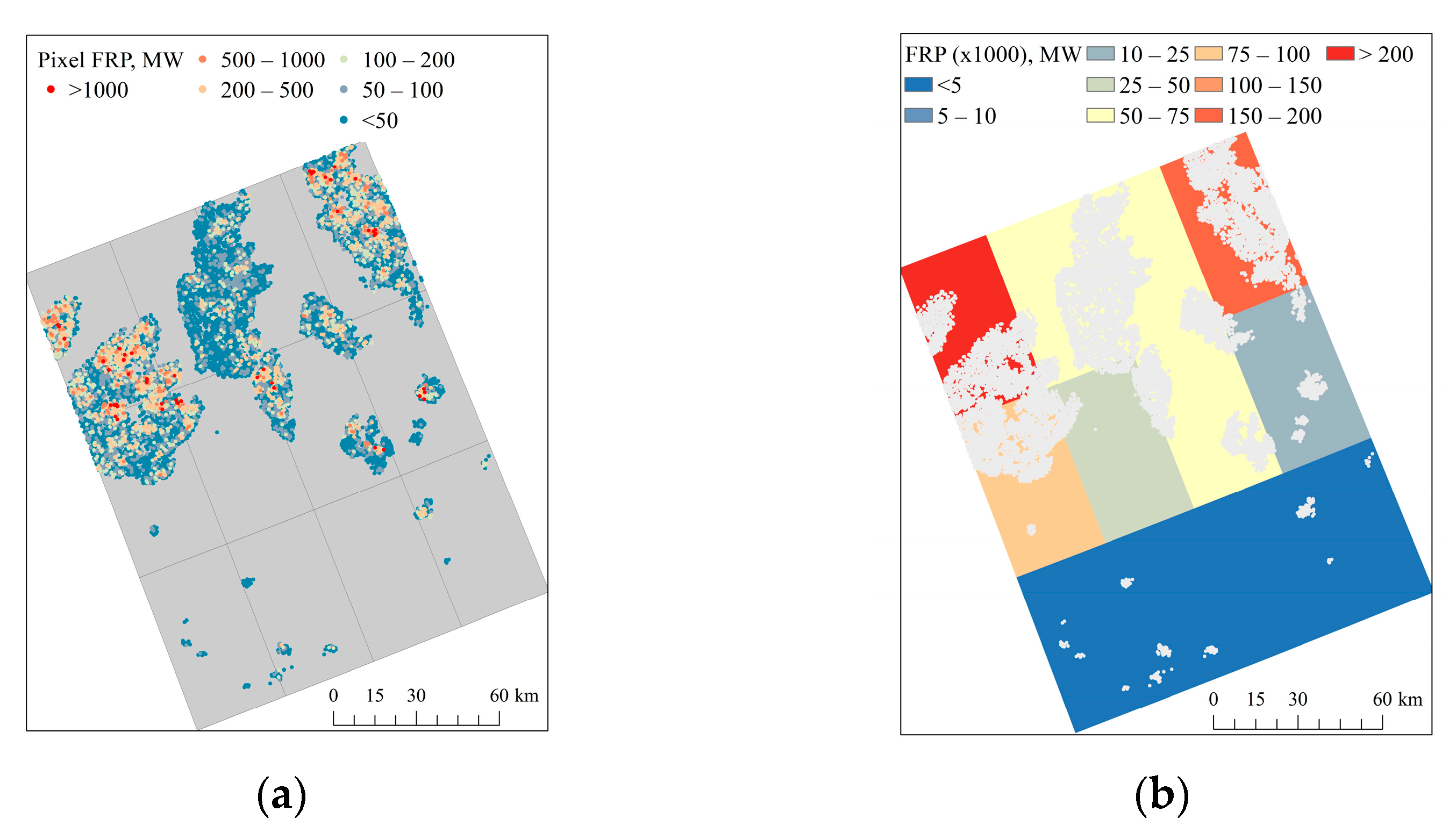

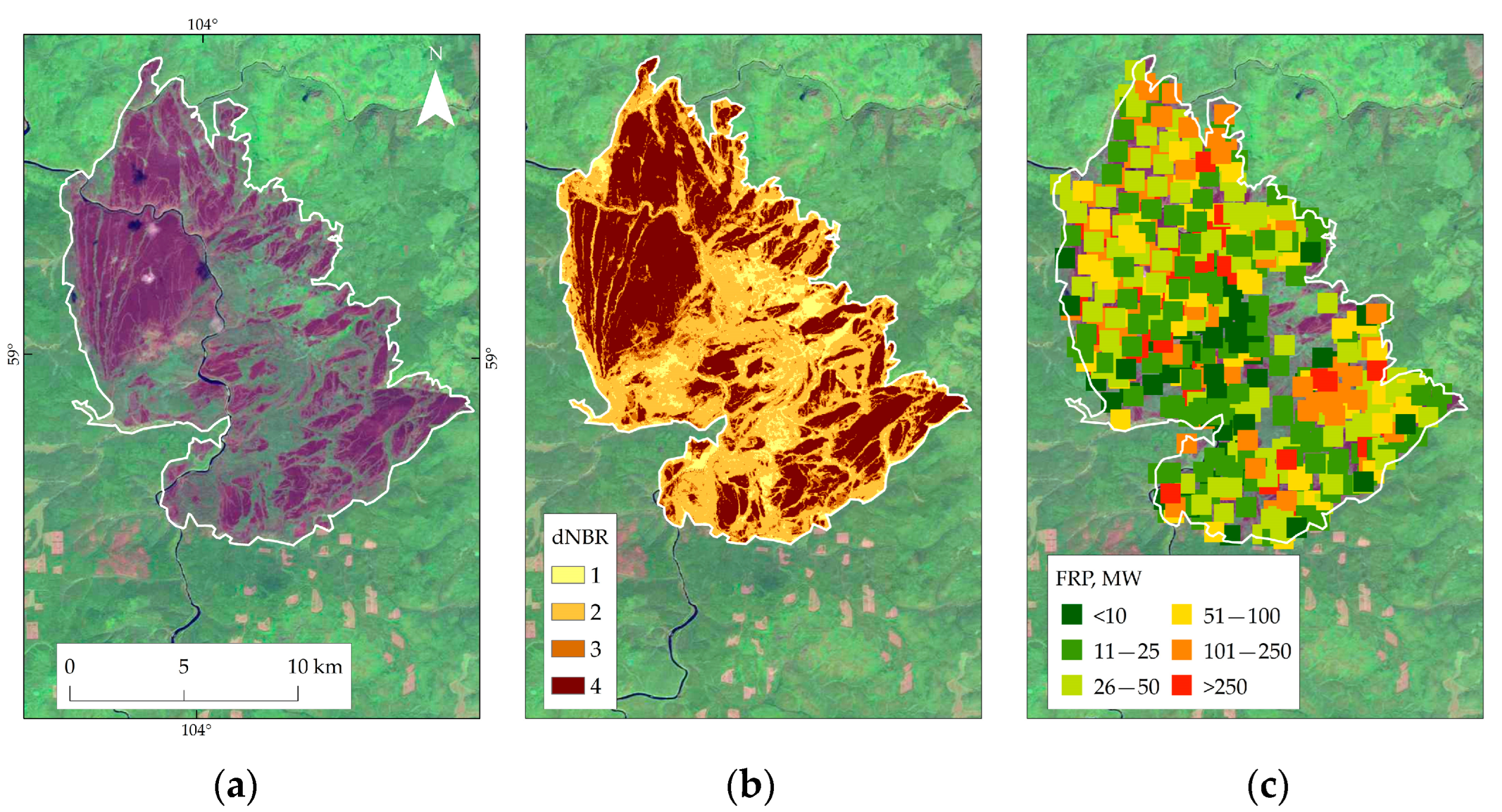
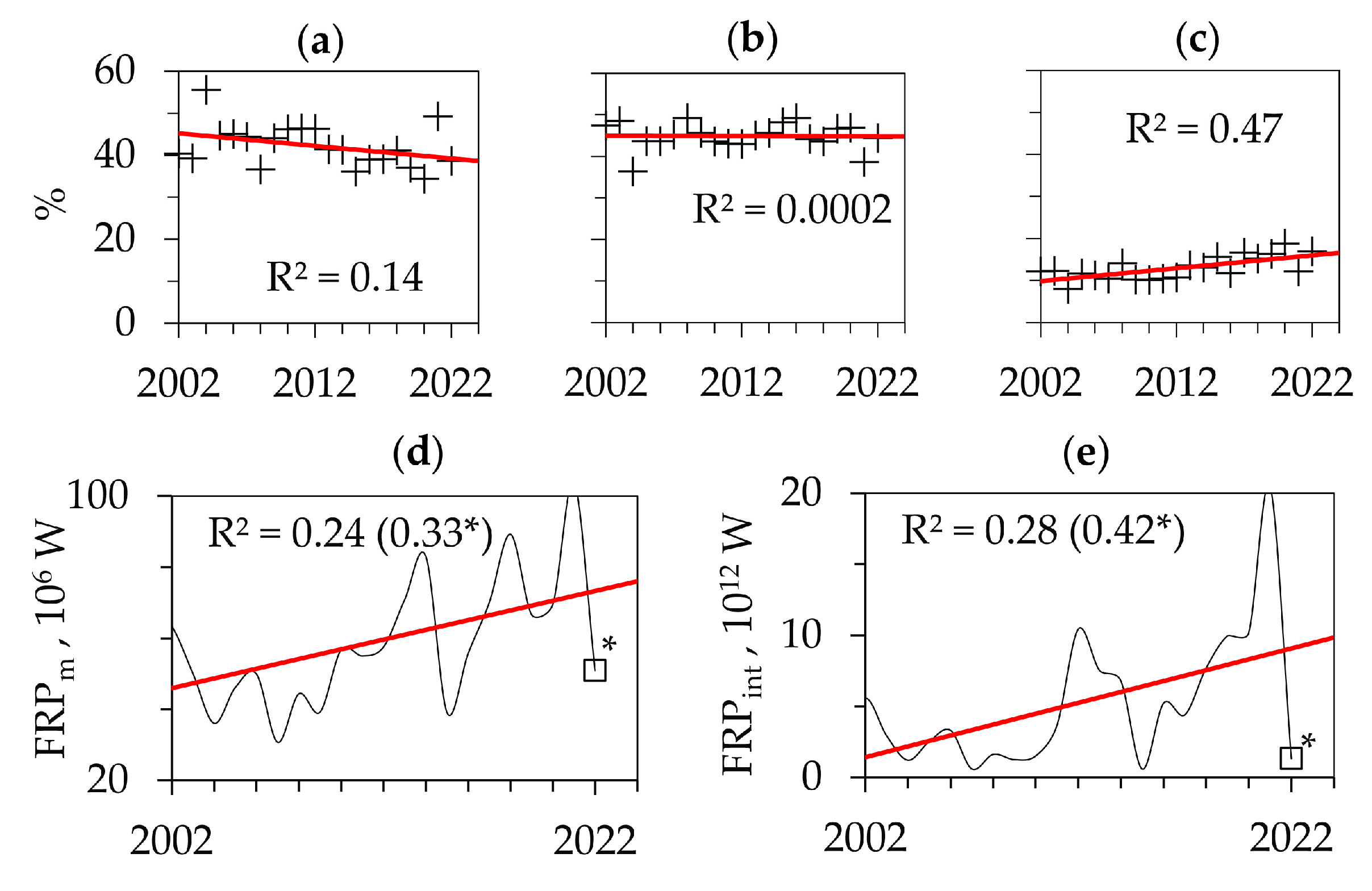

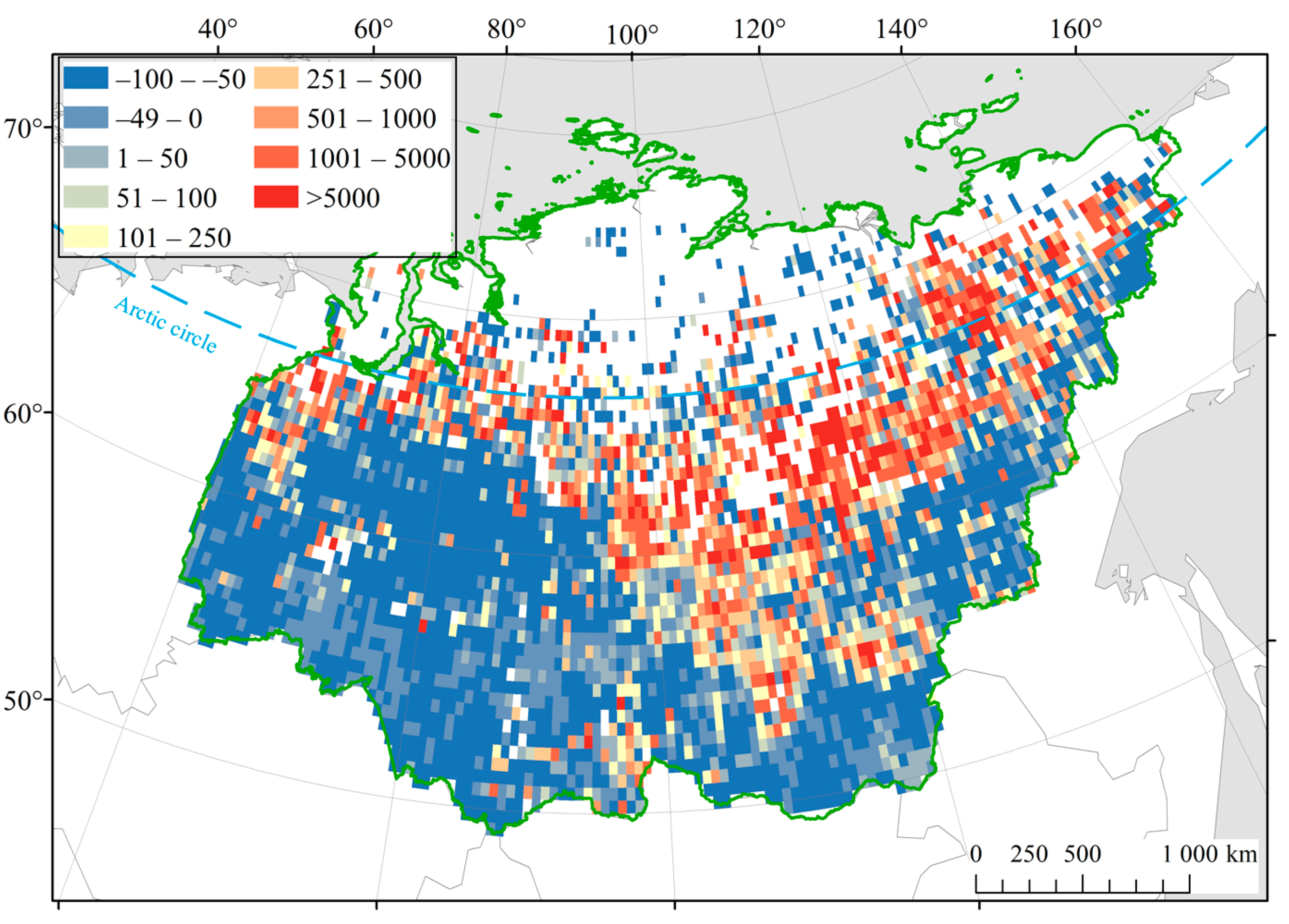
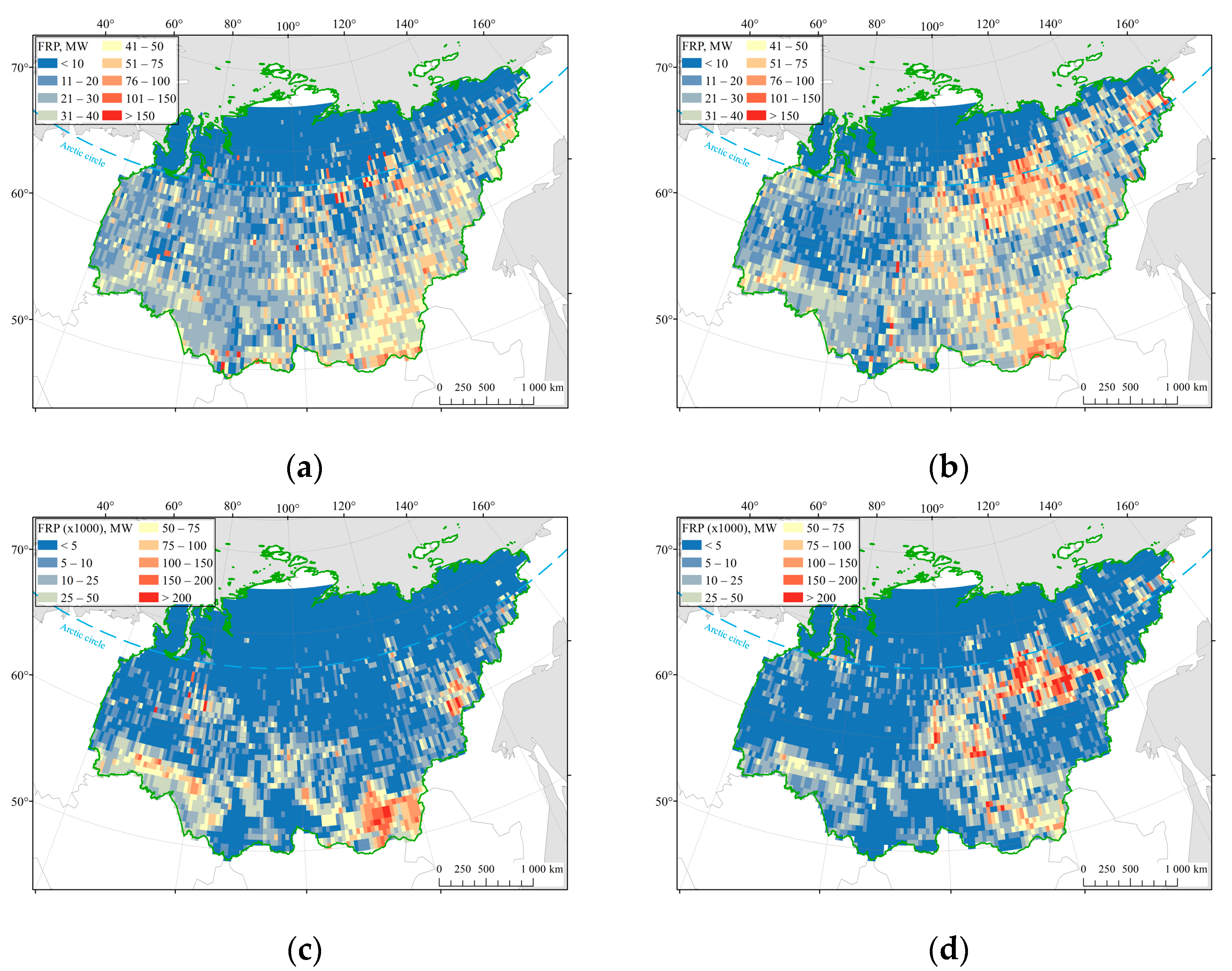
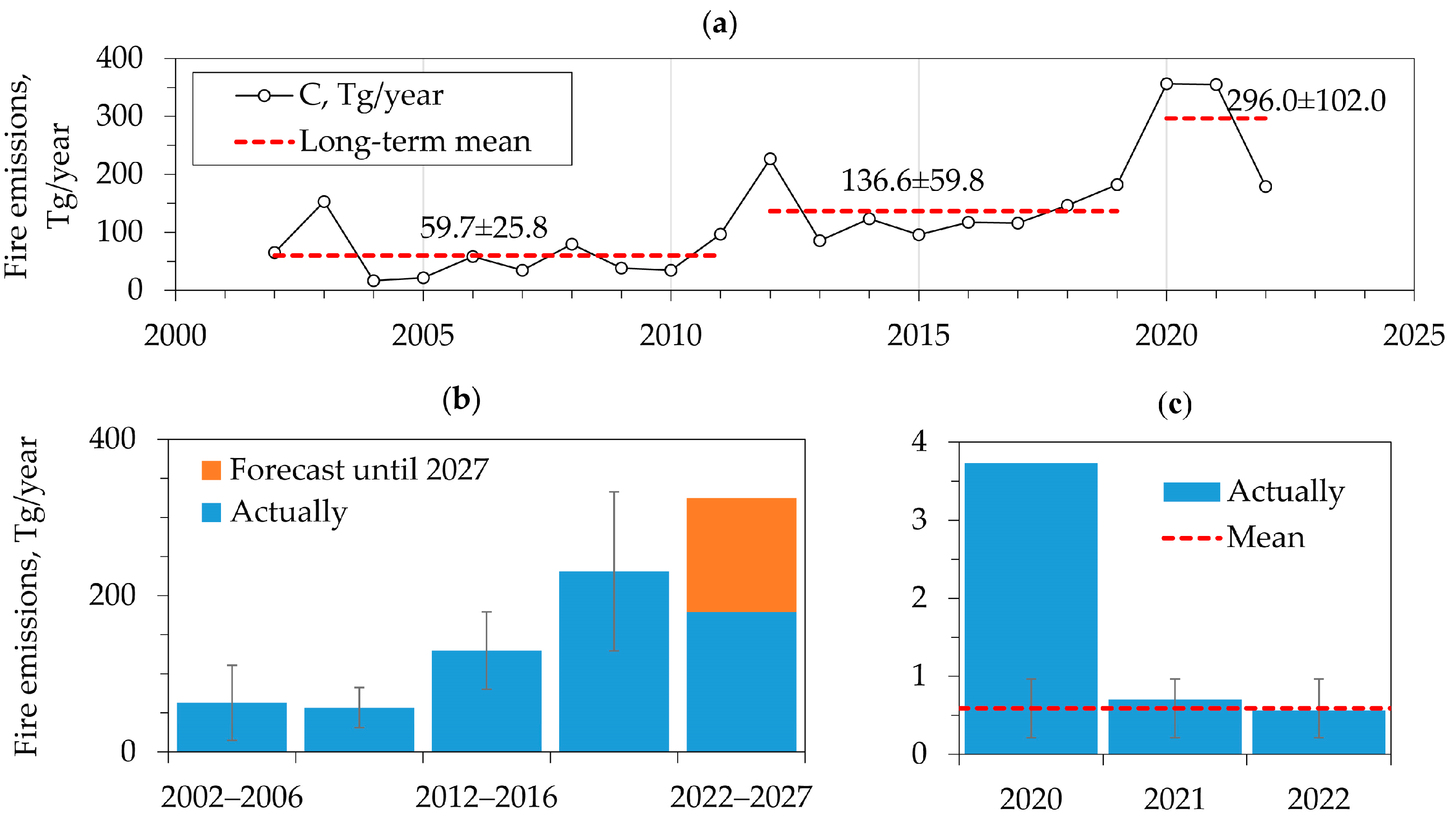
| Tree Stand | Number of Fire Event | Pre-Fire Image Data | Post-Fire Image Data |
|---|---|---|---|
| Larch (Larix sibirica) | 7 | 2 July 2017 | 14 September 2018 |
| 27 June 2019 | 16 August 2020 | ||
| 15 June 2019 | 4 August 2020 | ||
| 21 July 2020 | 21 September 2021 | ||
| 9 September 2020 | 12 September 2021 | ||
| 21 May 2020 | 28 August 2021 | ||
| 23 August 2020 | 18 September 2021 | ||
| Sparse larch | 5 | 12 July 2018 | 28 July 2018 |
| 21 July 2017 | 12 September 2018 | ||
| 4 July 2019 | 16 August 2020 | ||
| 1 September 2019 | 6 September 2021 | ||
| 22 June 2021 | 26 September 2021 | ||
| Pine (Pinus sylvestris) | 6 | 5 August 2017 | 25 September 2018 |
| 6 August 2017 | 10 September 2018 | ||
| 22 July 2020 | 11 September 2021 | ||
| 5 June 2021 | 9 September 2021 | ||
| 24 August 2020 | 12 September 2021 | ||
| 17 June 2019 | 1 September 2021 | ||
| Tundra vegetation | 5 | 8 June 2019 | 11 August 2019 |
| 8 June 2019 | 18 August 2019 | ||
| 25 June 2019 | 13 September 2019 | ||
| 25 June 2019 | 13 September 2019 | ||
| 9 August 2019 | 13 September 2019 | ||
| Cedar elfin wood (Pinus pumila) | 5 | 20 August 2018 | 16 August 2020 |
| 9 June 2018 | 14 August 2019 | ||
| 28 June 2017 | 1 September 2019 | ||
| 28 June 2017 | 1 September 2019 | ||
| 9 September 2020 | 12 September 2021 | ||
| Siberian pine (Pinus sibirica) | 5 | 23 July 2017 | 10 September 2018 |
| 6 August 2017 | 10 September 2018 | ||
| 16 June 2016 | 19 June 2017 | ||
| 23 July 2015 | 11 September 2016 | ||
| 23 August 2020 | 25 July 2021 |
| Category | Dnbr | Disturbance Degree |
|---|---|---|
| 1 | <0.269 | Low |
| 2 | 0.270–0.439 | Low-moderate |
| 3 | 0.440–0.659 | Moderate |
| 4 | >0.660 | High |
| Years | Average Area, mln ha | ||
|---|---|---|---|
| LIF | MIF | HIF | |
| 2002–2011 | 2.3 ± 1.5 | 2.5 ± 1.8 | 0.6 ± 0.4 |
| 2012–2019 | 3.4 ± 3.0 | 3.6 ± 3.0 | 1.4 ± 0.5 |
| 2020–2022 | 6.6 ± 2.9 | 6.9 ± 2.4 | 2.5 ± 1.0 |
| Years | Specific Emissions, t C/ga | ||
|---|---|---|---|
| x1 | x2 | x3 | |
| 2002–2011 | 9.0 | 12.0 | 15.0 |
| 2012–2019 | 10.0 | 12.4 | 20.3 |
| 2020–2022 | 10.0 | 14.5 | 38.8 |
| Tree stands | Subregion | Loads, t/ha | Reference |
|---|---|---|---|
| Light coniferous forests (Larix sibirica, L. gmelinii, Pinus sylvestris) | Larch forests/Eastern Siberia, Yakutia | 14.5–23.0 | Chevychelov, 2019 [37] |
| Larch forests/Central Siberia | 18.0–18.8 | Pleshikov et al., 2002 [33], Prokushkin, 2006 [34] | |
| Larch forests/waterlogged taiga of Central Siberia | 21.0–60.0 | Sergeeva et al., 2020 [38] | |
| Larch forests/southern taiga of Central Siberia | 48.6–65.0 | Ivanova et al., 2022 [40] | |
| Pine forests/Eastern Siberia, Yakutia | 5.7–7.8 | Chevychelov, 2019 [37] | |
| Pine forests/Central Siberia | 6.6–14.5 | Vedrova, 2012 [36], Pleshikov, 2002 [33] | |
| Pine forests/southern taiga of Central Siberia | 37.5–49.5 | Ivanova et al., 2022 [40] | |
| Dark coniferous forests (Pinus sibirica, Picea obovata, Abies sibirica) | Southern taiga of Central Siberia | 5.0–7.5 | Vedrova, 2012 [36] |
| Central Siberia | 9.0–14.0 | Pleshikov, 2002 [33] | |
| Deciduous forests (Betula spp., Populus tremula) | Central Siberia | 5.0–6.0 | Pleshikov, 2002 [33] |
| Tundra and cedar elfin wood (Pinus pumila) | Tundra of Western Siberia | 15.0 | Gerber, 2021 [39] |
Disclaimer/Publisher’s Note: The statements, opinions and data contained in all publications are solely those of the individual author(s) and contributor(s) and not of MDPI and/or the editor(s). MDPI and/or the editor(s) disclaim responsibility for any injury to people or property resulting from any ideas, methods, instructions or products referred to in the content. |
© 2023 by the authors. Licensee MDPI, Basel, Switzerland. This article is an open access article distributed under the terms and conditions of the Creative Commons Attribution (CC BY) license (https://creativecommons.org/licenses/by/4.0/).
Share and Cite
Ponomarev, E.I.; Zabrodin, A.N.; Shvetsov, E.G.; Ponomareva, T.V. Wildfire Intensity and Fire Emissions in Siberia. Fire 2023, 6, 246. https://doi.org/10.3390/fire6070246
Ponomarev EI, Zabrodin AN, Shvetsov EG, Ponomareva TV. Wildfire Intensity and Fire Emissions in Siberia. Fire. 2023; 6(7):246. https://doi.org/10.3390/fire6070246
Chicago/Turabian StylePonomarev, Evgenii I., Andrey N. Zabrodin, Eugene G. Shvetsov, and Tatiana V. Ponomareva. 2023. "Wildfire Intensity and Fire Emissions in Siberia" Fire 6, no. 7: 246. https://doi.org/10.3390/fire6070246
APA StylePonomarev, E. I., Zabrodin, A. N., Shvetsov, E. G., & Ponomareva, T. V. (2023). Wildfire Intensity and Fire Emissions in Siberia. Fire, 6(7), 246. https://doi.org/10.3390/fire6070246







